The Coffeyville Defenders
The Slain, The Injured, The Heroes
The Slain
Son Of A Minister Was The First To Fall At The Hands Of The Daltons
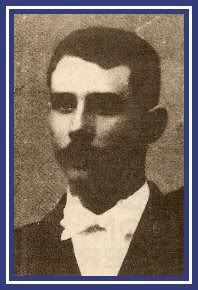
Lucius Baldwin, the first defender to fall during the Dalton Raid Oct. 5, 1892. |
Lucius Baldwin, the first defender to fall, mortally wounded, during the Dalton Raid Oct. 5, 1892, was born at Burlington on Feb. 24, 1869, to Mr. and Mrs. D.S. Baldwin.
The following is excerpt from an obituary written about Baldwin in the Burlington newspaper at the time:
"At the age of three years, his father entered the Methodist itinerancy, and thereafter for 17 years, Lucius had a parsonage home. The fifth charge served by Rev. Baldwin was Coffeyville, the sense of the late sad tragedy. Here father and son impressed their personality by self-forgetful devotion to others. He received a good education in the public schools, and was attending Baker University for a time. He possessed a natural business tact, and had he lived would have doubtless reached eminent success.
Commercially, at the time of his death he was head clerk with Read Brothers, a large mercantile establishment of Coffeyville. He was a active Christian worker, devoted charter member of the Epworth League of this city. He was for a time president of the League of Coffeyville. The members of this place attended in body to his funeral, one of the largest ever held in this city. Of Lucius it was surely said he was a young man of correct habits of life, of good deportment, loved by his companions because of the grace of character that were in his, affable spirit, ambitious in aims, of clean speech, and his lips unfouled by profanity, tobacco or strong drink. As he lived he died, for others.
|
What was secured by the death of the Coffeyville citizens was of immeasurable worth to the whole country, the ending of the criminal career that would doubtless have caused the loss of much property and the loss of many more innocent lives, had they escaped. Sad indeed that a beautiful and prominent young life like that of Lucius Baldwin, should have to go out at the hands of a Dalton villains."
"The words used as a text on the occasion of his funeral were:
"As a man fallest before wicked men, so fellest thou, and all the people wept again over him." I Sam. 3-34. "The afflicted ones have the sincere sympathy of the entire community."
George Cubine Only Slain Defender To Get Shot Off
The following is an obituary written for George Cubine, who was killed during the Dalton Raid, that appeared in the Coffeyville Journal at the time:
"Geo. B. Cubine was born on Walker's Creek, Virginia, August 25th 1856. His father died in 1862, leaving his widow and four small children. At the age of 19 George came to Kansas to live with his uncle, J.W. Cubine, of this city. He married December 29th, 1881, to Alice A Keyton, daughter of Thomas and Mary Keyton. Three children have been born to them. Jennie, born October 20th 1882, died December 31th the same year; Charlie, born January 9th, 1885, survives, Ethel, born September 18th, 1890, died August 27th, 1891.
At the age of 16 he was converted and became a member of the M.E. Church, South. After he left Virginia he never had the opportunity of uniting with that denomination and was not a member of any church at the time of his death. He had a strong faith in God, and a veneration for all things good. His good qualities were best known to his immediate friends and relatives. Warm hearted and generous, a loving husband and father, a true friend and always quick to aid.
We know how impulsively he left his work, snatched the Winchester from its place, and rushed to help his townsmen protect their property. As a mechanic (shoemaker) his loss is irreparable; he was unsurpassed for swiftness at his work; honest and faithful to the interest of others. The blow falls with a crushing force on a aged mother, a helpless invalid brother and a married sister and brother. In the family of his uncle, where he made his home for so many years, there is bitter mourning as over a dear son and brother. His wife and uncle were both away from home at the time of his death, and this adds greatly to their sorrow, at the loss of one whose memory will ever be gratefully and affectionally remembered." |
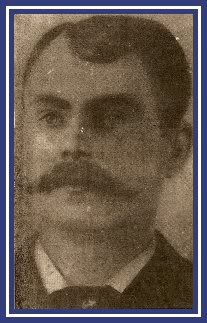
George B. Cubine was born on Walker's Creek, Virginia on August 25th 1856. |
Brown Picked Up Fallen Defender's Rifle During Raid.

Charles brown was born at Schenectady, New York, Dec. 26, 1832. |
Following is an obituary written for Charles Brown, the third to fall mortally wounded during the raid, which appeared in the Coffeyville Journal at the time.
Charles Brown was born at Schenectady, New York, December 26, 1832. When he was but eight years of age he went to Rachesterm N.Y., where he remained for seven years, during which time he completed his apprenticeship as a shoemaker. In 1846, when only fifteen years of age, he went to California and engaged in gold mining for about thirteen years.
In 1861, he returned to his native state where he remained but a short time. His next move was to Wayland, Michigan, where he married Miss Emily L. Morley in the year 1868. Two years afterward, he moved to Grand Rapids, where he worked at this trade until the fall of 1883, when he moved on a farm three miles east of Coffeyville. He moved to this city in 1888, and opened a shoe shop, where he remained working at his trade up to the time of his sad and tragic death at the hands of The Daltons on the 5th of October, 1892.
He leaves an aged widow in dependent circumstance who has the heart-felt sympathy of all in her great sorrow. The funeral services were held on Saturday afternoon at 3 o'clock in the M.E. church, and were conducted by Rev. McDole, who delivered a very touching and appropriate discourse. The deceased was a member of the Methodist Church, an honorable, upright, industrious citizen, and enjoyed the confidence and respect of his fellow men."
|
Marshal Was Also Respected Educator
The following is an obituary written for Charles T. Connelly the last defender to fall in the battle against the Daltons Gang, which appeared in the Coffeyville Journal at the time.
"Charles T. Connelly was born in the state of Indiana, November 25th, 1845, where he resided until he moved to Kansas in 1885. He enlisted in the Ninth Indiana Battery at the age of 17 years and served his country gallantly until the close of the Civil War.
"In the year 1867 he was married to Mary McCord. Two children, Bert and Grace, blessed their union. His wife die in 1874. Two years after her death, he was married to Sarah Alexander. This union was also blessed with two children, but one of whom is living, Miss Jessie, as a teacher in our city schools,
"Mr. Connelly was ever faithful and efficient, and enjoyed the confidence and esteem of his pupils. As city marshal he discharged his duty with great courage, and absolute fidelity to the best interest of the city. He gave his life freely in defense of the lives and property of our citizens, and his faithfulness to duty will ever be held in grateful remembrance by the people of Coffeyville. The deepest sympathy of the entire community goes out to the bereaved wife and children as they mourn the loss of a loving and devoted husband and father." |

Charles T. Connelly was the last defender to fall in the battle against the Dalton Gang |
The Injured
Defenders Put Their Lives On The Line For The City

Thomas G. Ayres was perhaps the luckiest of the defenders who was wounded on Oct. 5, 1892. |
A cashier at the First National Bank, Ayres was one of three bank workers who were captured along with three customers by Bob and Emmett Dalton.
Ayres was born May 7, 1842 in Andover Ill., and admitted to the bar in Cambridge, Ill., February 25, 1871. Seeking new challenges he moved to Coffeyville May 25, 1880, to engage in a banking business known as Ayres and Steele. That partnership was dissolved, and Ayres became an organizer of the First National Bank.
A lawyer in trade, Ayres ran for probate judge in 1882, but lost by 15 votes to Thomas Harrison, one of the country's oldest and most-respected citizens.
On the day of the Dalton Raid, Ayres, bookkeeper Bert Ayres and teller W.H. Shephard were toiling in the First National Bank as Bob and Emmett stepped in. The men, prompted by the Dalton's rifles, filled sacks with as much as $20,000 in cash, coinage and gold.
|
As the sound of gunfire rose on the plaza, the Dalton's ordered Shephard to lead them to the back door of the bank. Ayres escaped out the front door and dashed into the adjacent hardware store, Isham's.
Seeing a Winchester, Ayres positioned himself in the north doorway of the store, expecting to fire on Bob and Emmett Dalton as they passed out the front door of the bank. In the mean-time, the duo had passed around the north end of the block, killing three men in the process.
When they passed the center of the plaza, Bob Dalton spotted Ayres in the doorway. He fired at a distance of some 75 yards, striking Ayres just below the left eye. The bullet crashed through Ayres head and came out near the base of the skull.
The gruesome wound should have marked Ayres demise, but he clung to life. Eventually healed completely, Ayres understandably retired from the banking business to serve as treasurer for a wholesale grocery company in Sioux City, Iowa.
He returned to Coffeyville in December 1894 to practice law, and later served one term as the city's mayor.
Charley Gump
Gump was a local drayman, a freight-handler who piloted a horse and wagon. Gump was also a furniture crafter and repairman.
The Ohio native was 32 years old on Oct. 5th, 1892, when he spied The Dalton Gang attempting to rob the Condon and First National Banks of Coffeyville, the town he first called home in 1878.
Witnesses said Gump began shouting out notice that the Daltons were robbing the banks, and quickly grabbed a shotgun. Before Gump could get a shot off, a slug from the Winchester of Bob Dalton crashed through his right hand. Reports indicate the bullet not only disabled Gump, but shattered his gun into several pieces.
Gump sprinted off the field of battle and into Isham's the raids first casualty.
|
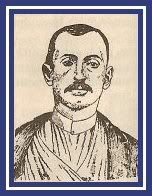
Charley Gump is credited by many as the man who sounded the alarm that the Daltons were in town. |
Later, Gump worked in his son Cleo's auto shop located on Central Street in Coffeyville. He engaged in a skill described as "toggery", or the application of canvas or cloth auto tops on early cars after the paint and body work was completed.
One account stated that Gump was awarded $1,200 from a fund raised by popular subscription.
T. Authur Reynolds
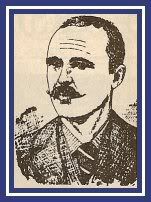
T. Authur Reynolds was the third citizen wounded by the Daltons. |
Located in Isham's with fellow clerk Louis A. Deitz and H.H. Isham, Reynolds was too exuberant in the defense for his own health.
A native of Kansas, Reynolds was born in 1859 and moved to Coffeyville in 1890.
Reynolds, described by Elliott as "intrepid," seized a Winchester from the store and sprang out onto the pavement. While firing several shots at a robber standing just inside the southeast door of Condon Bank - the bandit was later identified as Dick Broadwell - Reynolds had exposed himself to hostile fire.
A slug from Broadwell's rifle glanced off an object near Reynolds and entered the defender's right foot at the base of the little toe, exiting at the instep. Reynolds was the third man wounded, and the third to seek refuge in Isham's, where the floor had become soaked with citizens blood. |
The Heroes
John Kloehr Killed Two Daltons, Shot Two More
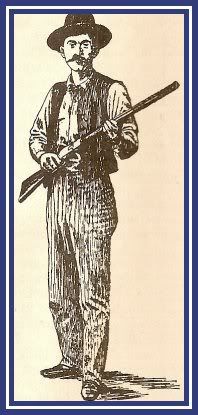
Kloehr is credited with firing the shot that killed Bob and Grat Dalton. |
Kloehr is credited with firing the shot that killed Bob and Grat Dalton, but he apparently didn't seek recognition for his heroic acts in the heart of "Death Alley."
According to eye-witness accounts, Kloehr calmly stared down Bob Dalton in the waning moments of the raid. The Daltons and their henchemen were trying to get to their horses, which were tied near a barn, Kloehr and other Cofeeyville defenders stood in their way.
Kloehr and Bob Dalton came face-to-face. Both fired their rifles. The outlaw missed, but Kloehr didn't, hitting the robber in the center of his chest.
Then Grat Dalton, pinned behind an oil cart, shot wildly at Kloehr and other defenders. Kloehr took deadly aim and shot the other Dalton through the throat, instantly killing him.
His action made him an instant celebrity in Coffeyville.
|
After the raid, Lyman Gage, then president of the First National Bank of Chicago Ill., and later President McKinley's secretary of the treasury, helped rasie a fund of $1,000 and had manufactured a gold medeal with a diamond in the center.
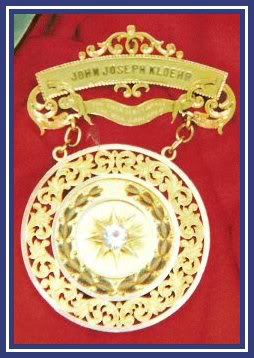 |
The medal was engraved, "John Joseph Kloehr - the Emergency Arose and the Man Appeared." And the opposite side says, "Presented by friends in Chicago ILL. who admire nerve and courage when displayed in defense of social order."

Kloehr also received a Winchester repeating rifle, a pair of rubber boots and a hunting jacket. |
Kloehr was born in 1858 in Germany. He came to America in 1870 with his family. In 1884 he married Katherine Huff. The couple eventually had four children - Jessie, born in 1885; Russell, 1887; Francis, 1888; and Nannie, 1893.
Kloehr also engaged with the government in handling cattle on the Canadian river for a year, spent about a year prospecting precious metals in Colorado, and then returned to Coffeyville. He then started buying and selling horses, which lead him into the livery business. He ran a livery business for a time, which he later developed into a storage garage business. While still maintaining his business, Kloehr became Coffeyville's Chief of Police. In 1908, he instituted the use of a gold police chief's badge.
Kloehr died in 1927.
Carey Seaman Wounded Emmett Dalton
| Carey Seaman is generally credited with stopping the final bandit, Emmett Dalton, with a double-barreled blast from a shotgun.
Seaman was a local barber who quickly armed himself with the "scattergun" dashing up Ninth Street and through several lots with J.J. Kloehr to approach the Daltons from a southerly direction.
Emmett Dalton, wounded by at least two bullets already, had mounted his horse and perhaps could have safely exited the town with up to $20,000 pirated from First National Bank. But he returned in a valiant attempt to save his brother, Bob, and buckshot from Seaman's gun crashed into young Dalton's back, dropping him and ending the fight. |
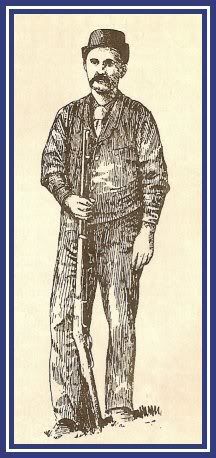
Carey Seaman is generally credited with stopping the final bandit, Emmett Dalton. |
|












